With vacation and all, it’s been awhile since we had one of our online cooking challenges. We came up with this idea to have a more random selection of ingredients that we’re giving a shot at – we each came up with a list of a few dozen ingredients that over time we’d have thrown in the pot, we put them all on a spreadsheet, and then we used a random number generator to pick four of them.
So what came up? Coconut. Eggs (poultry). Oregano. Rosemary. Well we didn’t see that one coming. We’d talked a little about how we might handle it if, say, 2-3 proteins came up that had to be combined (not that we haven’t done that – we did chicken and crab for the last challenge, and lamb and mussels for the very first). And while eggs are a protein, it then brought up the question – are we making a dinner main course only? Because eggs, versatile as they are, aren’t usually our first thoughts for dinner. We decided no, we’d never said that it had to be a main course, and there’s also no reason another protein couldn’t be brought into the mix, as long as those four ingredients starred in it.
The actual online evening fell apart quickly – two of four of us had last minute schedule conflicts and we postponed until the next day, only to find that one of the four couldn’t do it, and then another work conflict popped up. So we cancelled the whole thing. But I had the ingredients sitting there, so I went ahead and tried it out, just to see. And then Jennifer told me she’d done the same later that evening. Up first, Jennifer:
Coconut, Egg, Rosemary and….Oregano
The first ingredient was easy, because coconut flour, desiccated coconut, shredded coconut and coconut oil lurk in my larder. Rosemary grows in several locations in the garden. And there’s a pot of Cuban oregano sitting on the veranda. How hard could combing any of those ingredients with egg be?
Coconut flour sounded like such a great idea when I first came upon it last winter. The paleo aspect was appealing; the gluten-free part, not so much. The sack set unopened until this challenge, and I’ll have to admit that it just wasn’t as thrilling as I’d hoped. The concept of making crackers with the coconut flour, rosemary, egg, and tahini sounded appealing, but the finished product resembled oil-soaked cardboard, And didn’t taste much better, too ugly to photograph. Next time, I think I’ll go with a coconut flour approach that offends the gluten-free and paleo crowd instead of trying to make a sad imitation of real food. I think I would start with revising a standard oatmeal cookie recipe by cutting back on regular flour, adding coconut flour, and increasing liquids.
On the other hand, coconut flour dusted lightly over fresh pineapple chunks was worth repeating. Soaking up the pineapple juice, the coconut flour took on the appearance of icing, elevating the status of everyday pineapple. But didn’t have the same effect when sprinkled on sliced tomatoes.
If asked to name the first herb that comes into mind, I’d bet that most folks would say oregano. It’s probably the first dried herb most of us stocked our first kitchens with – and then proceeded to relegate to pizza, spaghetti, and anything Italian. But what a lot of people don’t realize is that oregano comes in a zillion different varieties, some of which definitely don’t match our idea of what oregano is supposed to look like. After I’d admired a strange sort of succulent sitting in the corner of the Mexican Food café in the hood, the owner sent me home with a pot of what he assured me was oregano. Its leaves had an almost overpowering oregano perfume, but it didn’t look like any oregano I’d ever seen. Research proved it was Cuban oregano, and this challenge seemed the perfect time to try it out.
My first thought was to fry it in a garbanzo flour batter and use it as a garnish or appetizer. I might still do that sometime.
The oregano would end up in frijoles negros refritos (refried beans), but these would be everyday beans. The cast iron frying pan was fired up, and chopped onion and chile poblano and ground cumin were fried in coconut oil, the whole oregano leaves added toward the end. The frijoles negros, cooked from scratch several days before and pureed in the food processor, came next, and then some lemon zest and a dash of crushed chiles tossed in. The beans were not cooking down as much as I’d hoped, so I threw in a pinch of coconut flour, and within seconds, the beans turned into the thick paste that spells frijoles refritos. And the frijoles refritos would become the first layer of tostadas, which were topped off with sliced raw chayote, tomatoes, radish, and papalo. Now, that was a combination that worked!
And, on to me. I really have to get these guys to take more pictures of their process, don’t you think? Or maybe I have to stop taking so many?
For me, there are basically two reasons for participating in these challenges – to try out new techniques and to try out new combinations of flavors that I otherwise might not give a shot at. So my first thought when the list of ingredients came together (well, the first thought was, can we have a do-over?) was that there was no way that coconut was going to combine with oregano and rosemary, let alone, given how strong of flavors both of those are, were they going to combine with each other without dominating the dish. After that, most of my thoughts turned towards dessert – but as I went through various ideas, I realized that pretty much, none of them were going to be much of a stretch – a souffle, a custard, meringues – all things I’ve done many times before, just with some odd flavor combos.
The same came to mind when I started considering savory options – which could have included the same sorts of dishes, but add in things like omelettes, or some sort of egg preparation flavored with the other three ingredients. But again, nothing new there. So what to do… then I remembered a new little technique that I watched during my day at Maido in Lima, of injecting a hot liquid into an egg yolk to give it flavor… that was something that I’ve never tried. Would it work? And in one of the various online cooking competitions that I watched recently, one of the contestants did something with a traditional Filipino technique using charred coconut. The dish slowly came together.
First, I charred unsweetened coconut flakes – well, not quite charred – it was interesting, reading up on the idea, some people actually take it to the point of blackened and then create an ash from it, others only to a very dark toasting. And then I started seeing that there are people out there doing things with burnt coconut custards, and jams, and, hey, butter. So I dark toasted the coconut and then threw it in the blender and honestly, to my surprise, with no added liquid or oil, it turns into a shiny, smooth liquid (that, when it cools, hardens like a rock – you have to remelt it to use it), with this deep, rich flavor that’s like the coconut version of something like a dark tahini, and barely a hint of sweetness left. That, with a pinch of salt and pepper, became the “sauce” underneath.
At first I was just going to make a little sort of hors d’oeuvre with some egg yolks (or maybe whole eggs, fried) with the yolks injected with some sort of puree or oil made from the two herbs, but decided to go more substantial and at least make an appetizer. So I seasoned and rolled a rabbit loin, more or less a blank canvas, seared it in coconut oil (may as well add in a hint more of coconut), quickly brushed it with egg white and then rolled it in a mix of oregano, rosemary, garlic and pepperoncino. Then into the oven to cook through to medium, and then out and rested. Untied, sliced into three short cylinders.
I decided to sous vide the eggs – I hadn’t meant to have them go quite this far – one of the recommendations that was in one or another of my “modernist” sources was that rather than an hour at 66-67°C, you could get the same effect quickly at 72° if you took the eggs out after 25 minutes. Not. So these are a little bit more of a sort of “soft fudge” than the “thick syrup” texture, but they were still soft enough to inject. And I’d decided to bring in another element to combine with the rabbit and herbs, I heated a little brine from some black olives and injected them with that, an then perched them on top. (The kidney, I just ate, it was there.)
The flavors came together really well, I was actually surprised how well it all melded together. Now to put this into a format that I could serve at one of our dinners….
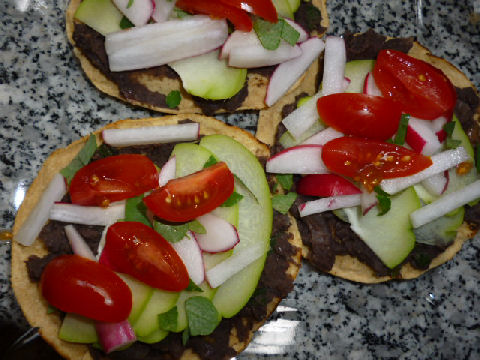
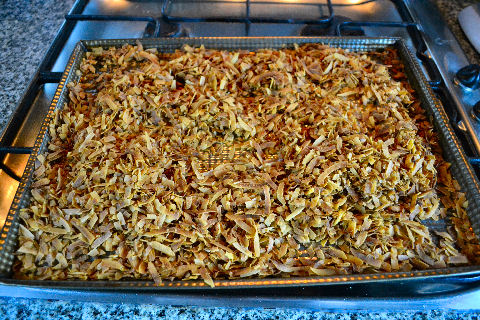
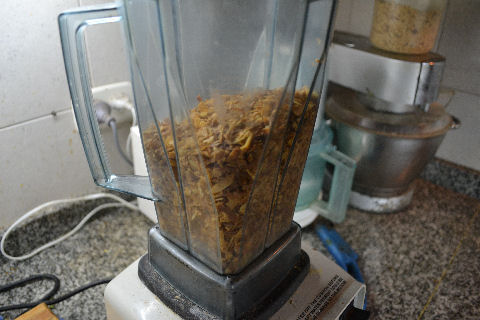
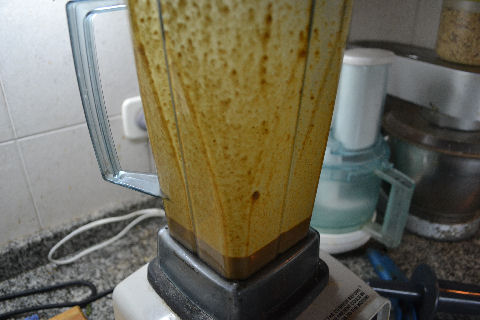
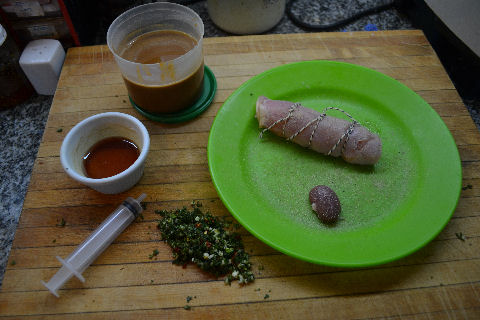
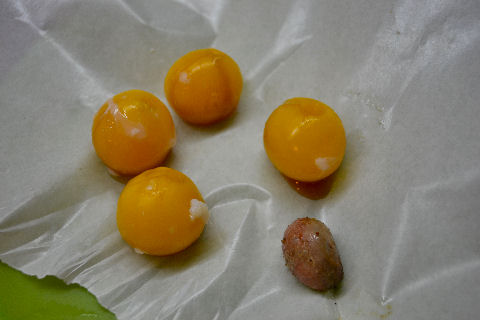
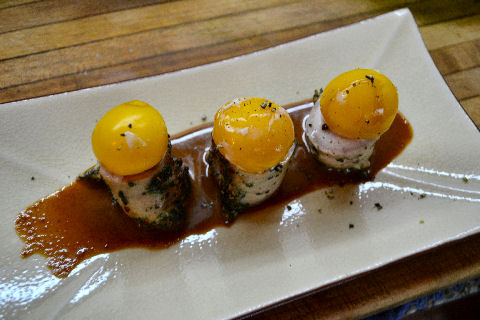
The coconut process is fascinating, but it looks like a commercial grade blender would be required to get those results.
From reading a few posts about making the coconut butter, it sounds like it can be done in a regular blender or even a food processor, it just takes longer.